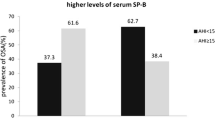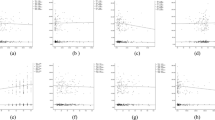Abstract
Purpose
Pulmonary surfactant (PS) plays roles in promoting the removal of the liquid, host defense, and immune regulation in the tracheal, bronchial, and alveoli epithelium. PS protein expression level can be regulated by oxygen levels and related free radicals. Obstructive sleep apnea (OSA) is featured with oxygen free radical production for damaging epithelial tissues and thus may affect PS production. The study was to explore the relationship between PS protein and OSA severity.
Methods
We collected serum and bronchoalveolar lavage fluid (BALF) samples from 35 OSA patients and 22 healthy subjects. PS-associated proteins and inflammatory factors, including surfactant proteins, HIF-1α, NF-κB, and IL-6, were analyzed. Regression analysis was performed to reveal the relationship between biochemical factors and clinical indexes recorded during PSG monitor.
Results
Lower BALF and surfactant protein (except surfactant protein C or SPC) levels occurred in OSA patients (all p < 0.05 compared to control group). A strongly negative correlation was found between surfactant protein with apnea-hypopnea index (AHI) and other sleeping indexes including ODI3 and ODI4. Similar patterns were found in serum samples, which were strongly correlated with BALF counterparts. Surfactant proteins were further found to have negative regression with inflammatory factors such as HIF-1α, NF-κB, and IL-6.
Conclusions
This study established the relationship between PS-related protein with severity of OSA, plus their relationship with inflammatory factors. Our results provided possibly novel markers in general circulation for disease evaluation of OSA.

Similar content being viewed by others
References
Speer CP, Sweet DG, Halliday HL (2013) Surfactant therapy: past, present and future. Early Hum Dev 89(Suppl 1):S22–S24
Andreeva AV, Kutuzov MA, Voyno-Yasenetskaya TA (2007) Regulation of surfactant secretion in alveolar type II cells. Am J Physiol Lung Cell Mol Physiol 293:L259–L271
Vives MF, Caspar-Bauguil S, Aliouat EM, Escamilla R, Perret B, Dei-Cas E, Prevost MC (2008) Hypobaric hypoxia-related impairment of pulmonary surfactant proteins A and D did not favour pneumocystis carinii Frenkel 1999 growth in non-immunocompromised rats. Parasite 15:53–64
White CW, Greene KE, Allen CB, Shannon JM (2001) Elevated expression of surfactant proteins in newborn rats during adaptation to hyperoxia. Am J Respir Cell Mol Biol 25:51–59
Ito Y, Ahmad A, Kewley E, Mason RJ (2011) Hypoxia-inducible factor regulates expression of surfactant protein in alveolar type II cells in vitro. Am J Respir Cell Mol Biol 45:938–945
Ryan S, Taylor CT, McNicholas WT (2005) Selective activation of inflammatory pathways by intermittent hypoxia in obstructive sleep apnea syndrome. Circulation 112:2660–2667
Winnicki M, Shamsuzzaman A, Lanfranchi P, Accurso V, Olson E, Davison D, Somers VK (2004) Erythropoietin and obstructive sleep apnea. Am J Hypertens 17:783–786
Belaiba RS, Bonello S, Zahringer C, Schmidt S, Hess J, Kietzmann T, Gorlach A (2007) Hypoxia up-regulates hypoxia-inducible factor-1alpha transcription by involving phosphatidylinositol 3-kinase and nuclear factor kappaB in pulmonary artery smooth muscle cells. Mol Biol Cell 18:4691–4697
Tong Q, Zheng L, Dodd-o J, Langer J, Wang D, Li D (2006) Hypoxia-induced mitogenic factor modulates surfactant protein B and C expression in mouse lung. Am J Respir Cell Mol Biol 34:28–38
Liang S, Li N, Heizhati M, Yao X, Abdireim A, Wang Y, Abulikemu Z, Zhang D, Chang G, Kong J, Zhou L, Hong J, Ying T, Zhang Y (2015) What do changes in concentrations of serum surfactant proteins A and D in OSA mean? Sleep Breath 19:955–962
Shao L, Li N, Yao X, Heizati M, Abdireim A, Wang Y, Abulikemu Z, Zhang D, Chang G, Zhou L, Hong J, Zhang Y, Kong J, Zhang X (2016) Relationship between surfactant proteins B and C and obstructive sleep apnea: is serum SP-B concentration a potential biomarker of obstructive sleep apnea? Sleep Breath 20:25–31
Kirkness JP, Madronio M, Stavrinou R, Wheatley JR, and Amis TC: Relationship between surface tension of upper airway lining liquid and upper airway collapsibility during sleep in obstructive sleep apnea hypopnea syndrome. J Appl Physiol (1985) 2003; 95: 1761–6
Kirkness JP, Madronio M, Stavrinou R, Wheatley JR, Amis TC (2005) Surface tension of upper airway mucosal lining liquid in obstructive sleep apnea/hypopnea syndrome. Sleep 28:457–463
Arnardottir ES, Mackiewicz M, Gislason T, Teff KL, Pack AI (2009) Molecular signatures of obstructive sleep apnea in adults: a review and perspective. Sleep 32:447–470
Cochrane CG, Spragg R, and Revak SD: Pathogenesis of the adult respiratory distress syndrome. Evidence of oxidant activity in bronchoalveolar lavage fluid. J Clin Invest 1983; 71: 754–761
Kiefmann R, Rifkind JM, Nagababu E, Bhattacharya J (2008) Red blood cells induce hypoxic lung inflammation. Blood 111:5205–5214
Takahashi H, Fujishima T, Koba H, Murakami S, Kurokawa K, Shibuya Y, Shiratori M, Kuroki Y, Abe S (2000) Serum surfactant proteins A and D as prognostic factors in idiopathic pulmonary fibrosis and their relationship to disease extent. Am J Respir Crit Care Med 162:1109–1114
Stapleton RD, Dixon AE, Parsons PE, Ware LB, Suratt BT (2010) The association between BMI and plasma cytokine levels in patients with acute lung injury. Chest 138:568–577
Winkler C, Atochina-Vasserman EN, Holz O, Beers MF, Erpenbeck VJ, Krug N, Roepcke S, Lauer G, Elmlinger M, Hohlfeld JM (2011) Comprehensive characterisation of pulmonary and serum surfactant protein D in COPD. Respir Res 12:29
Massaro GD, Massaro D (1983) Morphologic evidence that large inflations of the lung stimulate secretion of surfactant. Am Rev Respir Dis 127:235–236
Sin DD, Pahlavan PS, Man SF (2008) Surfactant protein D: a lung specific biomarker in COPD? Ther Adv Respir Dis 2:65–74
Wirtz HR, Dobbs LG (1990) Calcium mobilization and exocytosis after one mechanical stretch of lung epithelial cells. Science 250:1266–1269
Wirtz H, Schmidt M (1992) Ventilation and secretion of pulmonary surfactant. Clin Investig 70:3–13
Aderibigbe AO, Thomas RF, Mercer RR, Auten RL Jr (1999) Brief exposure to 95% oxygen alters surfactant protein D and mRNA in adult rat alveolar and bronchiolar epithelium. Am J Respir Cell Mol Biol 20:219–227
Guo Y, Yang MC, Weissler JC, Yang YS (2007) PLAGL2 translocation and SP-C promoter activity—a cellular response of lung cells to hypoxia. Biochem Biophys Res Commun 360:659–665
Braems GA, Yao LJ, Inchley K, Brickenden A, Han VK, Grolla A, Challis JR, Possmayer F (2000) Ovine surfactant protein cDNAs: use in studies on fetal lung growth and maturation after prolonged hypoxemia. Am J Physiol Lung Cell Mol Physiol 278:L754–L764
Ciccone MM, Scicchitano P, Mitacchione G, Zito A, Gesualdo M, Caputo P, Damiani MF, Sassara M, Favale S, Resta O, Carratu P (2012) Is there a correlation between OSAS duration/severity and carotid intima-media thickness? Respir Med 106:740–746
Atkeson A, Jelic S (2008) Mechanisms of endothelial dysfunction in obstructive sleep apnea. Vasc Health Risk Manag 4:1327–1335
Damiani MF, Carratu P, Quaranta VN, Resta O (2012) Influence of obstructive sleep apnea on endothelial function in obese patients. Chest 141:1639 author reply 1640
He C, Chen B (2012) Sleep Related Breathing Disorders Team, Respiology Branch, Chinese Medical Association, OSA diagnosis and treatment guideline. Chinese Journal of Tuberculosis and Respiratory Diseases 35:9–12
KSS S, Veeramohan PH, Mathew T, S S, M C (2012) Nifedipine inhibits hypoxia induced transvascular leakage through down regulation of NFkB. Respir Physiol Neurobiol 183:26–34
Fitzpatrick SF, Tambuwala MM, Bruning U, Schaible B, Scholz CC, Byrne A, O'Connor A, Gallagher WM, Lenihan CR, Garvey JF, Howell K, Fallon PG, Cummins EP, Taylor CT (2011) An intact canonical NF-kappaB pathway is required for inflammatory gene expression in response to hypoxia. J Immunol 186:1091–1096
Ciccone MM, Scicchitano P, Zito A, Cortese F, Boninfante B, Falcone VA, Quaranta VN, Ventura VA, Zucano A, Di Serio F, Damiani MF, Resta O (2014) Correlation between inflammatory markers of atherosclerosis and carotid intima-media thickness in obstructive sleep apnea. Molecules 19:1651–1662
Author information
Authors and Affiliations
Corresponding author
Ethics declarations
Funding
No funding was received for this research.
Conflict of interest
All authors certify that they have no affiliations with or involvement in any organization or entity with any financial interest (such as honoraria; educational grants; participation in speakers’ bureaus; membership, employment, consultancies, stock ownership, or other equity interest; and expert testimony or patent-licensing arrangements), or non-financial interest (such as personal or professional relationships, affiliations, knowledge, or beliefs) in the subject matter or materials discussed in this manuscript.
Ethical approval
All procedures performed in the studies involving human participants were in accordance with the ethical standards of the institutional and/or national research committee and with the 1964 Helsinki declaration and its later amendments or comparable ethical standards.
Informed consent
Informed consent was obtained from all individual participants included in the study.
Rights and permissions
About this article
Cite this article
Lu, D., Abulimiti, A., Wu, T. et al. Pulmonary surfactant-associated proteins and inflammatory factors in obstructive sleep apnea. Sleep Breath 22, 99–107 (2018). https://doi.org/10.1007/s11325-017-1536-z
Received:
Revised:
Accepted:
Published:
Issue Date:
DOI: https://doi.org/10.1007/s11325-017-1536-z




